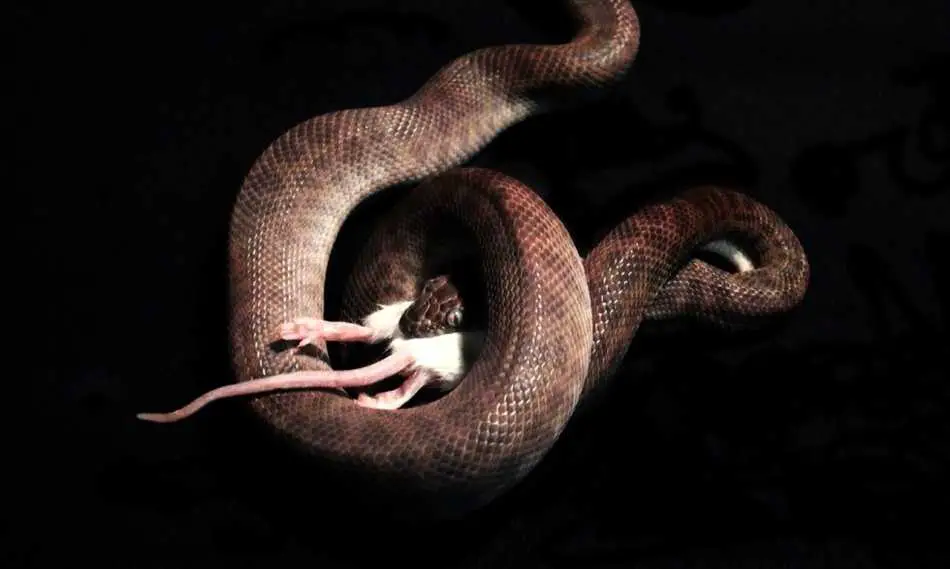 A snake is a great low maintenance pet, but they do have their quirks. Some are pickier than others about their food, and they don’t like to eat when they’re molting. Feeding live prey can be dangerous to your sweet snake. Even a small bite can get infected. It’s a risk many snake owners simply don’t want to take, so frozen food is a fantastic safe option. What’s the best way to thaw mice for your serpentine buddy? I’ll walk you through the steps and teach you about some of the essential issues related to feeding a snake frozen mice.
A snake is a great low maintenance pet, but they do have their quirks. Some are pickier than others about their food, and they don’t like to eat when they’re molting. Feeding live prey can be dangerous to your sweet snake. Even a small bite can get infected. It’s a risk many snake owners simply don’t want to take, so frozen food is a fantastic safe option. What’s the best way to thaw mice for your serpentine buddy? I’ll walk you through the steps and teach you about some of the essential issues related to feeding a snake frozen mice.
How To Thaw Frozen Mice For Snakes
The act of thawing frozen mice is relatively simple. Always store your frozen and thawing mice in a bag. Also, keep in mind that snakes don’t like damp food. If you use water to warm up their meal, then doublecheck that your bag is sealed, and most of the air is out before you place it in a container of lukewarm water.
- Take mice out of the freezer.
- Separate one frozen mouse of appropriate size into a plastic Ziploc bag.
- According to the USDA, it takes 8-10 hours per pound to thaw at room temperature. An average mouse takes 1-2 hours.
- Warm on a heating pad, or place the sealed bag in lukewarm (never hot) water until the mouse is warm. Snakes don’t like cold food.
For new snake owners or those who are looking for a new heating pad, I suggest the iPower Under Tank Heat Pad from Amazon. I like the easy to read LED readout on the digital thermostat, which makes it super simple to use. You can check prices and availability by clicking here.
Pro Tips For Thawing Mice
- You can thaw a frozen mouse in a bag using warm water. It takes about the same amount of time to make sure it’s not still a mouse-popsicle inside. However, if you thaw a mouse in the refrigerator, it will take longer than two hours due to the cold.
- Using a dedicated snake-food-thawing microwave is also an option. However, it’s easy to go overboard or undercook a frozen mouse this way. While it’s a myth that using a microwave destroys the nutrients in your food unnecessarily, keep in mind that cooking will reduce the nutritional value.
- A hairdryer will thaw a mouse in a pinch. Make sure it’s warm all the way through, and let it cool down before feeding as it may be too hot for your snake at first. An internal temp between ninety and a hundred degrees is fine. However, the same rule applies to hairdryers as microwaves; cooking slightly reduces the ‘food’ value of meals.
- When in doubt, check the internal temperature of the mouse. You can use a standard digital meat thermometer to check the temperature. Make sure you buy a dedicated thermometer and don’t use it for anything else. Additionally, you should always wash and sanitize the end you stuck in the mouse.
Can You Re-Freeze Uneaten Mice
Thawing mice for your snakes isn’t tricky once you have the handful of items you need. However, what do you do if your snake isn’t hungry and you have a thawed mouse on your hands? Can you refreeze it?
As a general rule, stick to the same guidelines you would for human foods. According to UNL Food, “Do not refreeze any foods left outside the refrigerator for longer than 2 hours; 1 hour in temperatures above 90 °F.” Beyond that, it’s a bad idea. Make sure you label the bag that the re-frozen mouse goes into, and use it again soon.
It’s also a good idea to keep in mind that you should never thaw and re-freeze more than once. Typically a snake should eat it’s food as long as it’s healthy, and you’re not feeding too often. Unless your snake is about to molt or just finished, then they’ll be hungry.
How Often Do Snakes Eat
How often do you need to thaw mice for your snake? Well, that depends on the age and size of your snake. Always consult with a professional breeder or vet on the best snake feeding practices when you’re first starting out, or if you have any issues.
Larger snakes and those who are more mature usually eat every week or two. Meanwhile, younger snakes and those who are small eat more often. Twice a week is average for a young snake. Like human children, they’re using all that food for energy to grow.
What Size Food Does Your Snake Need
Choosing frozen mice is just one option. Depending on the size of your snake, frozen rats, or pinkies (baby mice) may be a better option. It’s easy to determine the right food for your snake. The rule of thumb for snake feeding is to give them a thawed mouse (or other option) that is the same diameter around as your snake is at the widest point.
A simple way of figuring it out is to take a piece of thread or yarn and wrap it around the biggest part of your snake. Hold it taut to get an accurate measurement, but don’t squeeze. Slip the loop off and cut or mark the string at the right size. You can then use your string to measure the food to check the size.
When you need snake food, and you can’t get to the nearest pet store or you’d rather ‘order in’ than make special trips, there’s no need to worry. You can always order a UGRodents 50-Pack Frozen Fuzzy Mice (available in other sizes as well) from Amazon. To check prices and shipping times, click here.
How Long Do Frozen Mice Last
One of the keys to healthy snake feeding is thaw-order for your mice. Just as grocery stores place newer products at the back of the shelves, you should do the same. First in, first out is an easy way to remember how to rotate your frozen food stock. (This applies to people and other pets as well.)
How long your frozen supplies last depends on a few crucial factors. First, how airtight is the packaging? Oxygen will cause decay. Hence airtight bags need to be sealed and extra air removed. If you want to step things up a level, invest in a dedicated vacuum sealer for your snakes.
Most frozen, uncooked meats will last up to six months if they’re stored correctly. When you remove all the air, it can last longer. However, there’s another important factor in freezing that people often forget. Power outages can cause hiccups in your timeframe. If you have a summer or weather-related power problem that lasts more than a couple of hours, you could be looking at thawed mice. It’s alright to re-freeze if they’re only thawed briefly.
In case of a power loss, it’s always best to have a generator to run your fridge. However, if you can’t afford this sensible backup, then you should always go and get ice to pack your frozen goods in when there’s no electricity.
Picky Eater Snakes
When it comes to feeding thawed mice to snakes, it’s vital to know the difference between normal behavior and picky eating. First, snakes who are about to molt, in the process, or just finished, may not be as hungry as usual. Second, some snakes eat much less during the winter months.
Snakes may hesitate over food for other reasons as well. While not being hungry is a common snake ‘complaint,’ sometimes the food simply isn’t appetizing. When dealing with frozen feeder mice, you need to avoid freezer burn. Use the right freezer bags and remove all the air you can. Double bag to help prevent any moisture or additional issues.
Warming up the mice after they’re thawed will help assure your snake is interested. While it doesn’t guarantee a strike, it certainly makes them hesitate less when the food is the right temperature for a live mouse. The average median body temperature for a mouse is 36.6 °C or 97.88° F.
Finally, a snake may get bored with the flavor and source of the food, though that’s less likely. You can always try a new source if your snake doesn’t like their mice. However, I’d suggest making sure it’s not some other issue first. As always, when in doubt, ask your vet, especially if you suspect your snake is ill or injured.
Make sure your snake has a great place to curl up when they’re digesting their latest big meal. The Zilla Rock Cave attaches to the glass side of the terrarium with suction cups to help stabilize it. You can pick one up from Amazon by clicking here.
Final Thoughts
Feeding your snakes frozen mice is much safer than giving them a live meal. Claws and teeth on prey animals like mice can damage your pet severely. Fortunately, thawing mice isn’t tricky.
You can use any of the methods I detailed here will work to thaw your mice, but you don’t need to get fancy about it. Pull them out of the freezer and put them in your fridge the night before you intend to feed, and they’ll warm up much faster.
Snakes don’t like cold or freezer burnt food, so handle your mice with care for the best results. Happy snake feeding.
